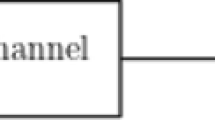Abstract
In this paper we propose first a generalized framework for the Maximum Likelihood decoding ofstbc. Using algebraic tools we then derive a new matrix model particularly well suited to the description ofmimo systems. After giving our particular detection rules we determine a new accurate upperbound for theber performances ofstbc transmitting schemes. Performance results are given which show the accuracy of the derived upperbound.
Résumé
Ce papier aborde le problème du décodage des codes temps-espace en blocs, les règles de décodage sont rappelées et une formulation matricielle particulièrement simple est obtenue pour une programmation rapide. Cette modélisation matricielle nous permet d’obtenir un calcul de borne supérieure duteb sur canal de Rayleigh non sélectif en fréquence. Les performances obtenues sont excellentes et montrent la précision des bornes obtenues.
Similar content being viewed by others
References
Balaban (N.),Salz (J.), “Dual diversity combining and equalization in digital cellular mobile radio”,ieee Trans. Veh. Technol.(1991),40, no 5 pp. 342–354.
Foschini Jr. (G. J.),Gans (M. J.), “On limits of wireless communication in a fading environment when using multiple antennas”,Wireless Personnal Commun. (1998).
Guey (J. C.),Fitz (M. P.),Bell (M. R.),Kuo (W. Y.), “Signal design for transmitter diversity wireless communication systems over Rayleigh fading channels”,in Proc. vtc’96, 1996,1, pp. 136–140.
Seshadri (N.),Winters (J. H.), «Two signaling schemes for improving the error performance of frequency-division-duplex (fdd) transmission systems using transmitter antenna diversity»,Int. J. Wireless Inform. Networks (1994),1, no1 pp. 342–354.
Telatar (E.), “Capacity of multi-antenna Gaussian channels”,at&t-Bell Laboratories Internal Tech. Memo., June 1995.
Tarokh (V.),Seshadri (N.),Calderbank (A. R.), “Space-time codes for high data rate wireless communications: Performance analysis and code construction (1998)”,ieee trans. Inform. Theory,44, no3, pp. 744–765.
Tarokh (V.),Naguib (A.),Seshadri (N.),Calderbank (A. R.), “Space-time codes for high data rate wireless communications: Performance criteria in the presence of channel estimation errors, mobility and multipaths”,ieee trans. Commun. (1999),47, no2, pp. 199–207.
Baro (S.),Bauch (G.),Hansmann (A.), «Improved codes for space-time trellis-coded modulation”,ieee Commun. Lett. (2000),4, no1, pp. 20–22.
Alamouti (S. M.), “A simple transmitter diversity scheme for wireless communications»,ieee J. Select. Areas. Commun. (1998),16, no10, pp. 1451–1458.
Tarokh (V.),Jafarkhani (H.),Calderbank (A. R.), “Space-Time Block Codes from Orthogonal Designs”,ieee trans. Inform Theory (1999),45, no7, pp. 1456–1467.
Tarokh (V.),Jafarkhani (H.),Calderbank (A. R.), “Space-Time Block Coding for wireless communications: Performance results”,ieee J. Select. Areas Commun. (1999),17, no 3, pp. 451–460.
Proakis (J. G.), “Digital Communications”, McGraw-Hill International Editions, 1995.
Author information
Authors and Affiliations
Additional information
Gholam RezaMohammad-Khani received hisbsc. andmsc. degrees in communication engineering from Sharif University of Technology, Tehran, Iran, respectively in 1992 and 1994. He worked as a lecturer in Mashhad University in 1997. His current research interests include multiuser detection and synchronization algorithms,mimo communication systems.
GuillaumeFerré: graduated in electrical engineering fromensil in 2003, he is now working towards the PhD at the University of Limoges.
Jean-PierreCances graduated in electrical engineering fromenst Bretagne in 1990. He received his Ph.D degree from Télécom Paris in satellite communication engineering in 1993. He is now an assistant professor at the Ecole Nationale Supérieure d’Ingénieurs de Limoges (ensil). His current research interests include satellite communication systems, multicarrier detection and synchronization algorithms,mimo communication systems.
VahidMeghdadi received hisbsc. andmsc. degrees in communication engineering from Sharif University of Technology, Tehran, Iran, respectively in 1989 and 1992. He worked as a lecturer in Mashhad University in 1993. Since 1994, he has been a Ph.D. student inEcole nationale Supérieure d’Ingenieurs de Limoges (ensil) where he is now an assistant professor. His current research interests include satellite communication systems, multiuserdetection and synchronization algorithms,mimo communication systems.
Rights and permissions
About this article
Cite this article
Mohammad-Khani, G.R., Ferre, G., Cances, JP. et al. Maximum likelihood decoding rules for STBC: Generalized framework for detection and derivation of accurate upperbounds. Ann. Télécommun. 59, 1228–1249 (2004). https://doi.org/10.1007/BF03179717
Received:
Accepted:
Issue Date:
DOI: https://doi.org/10.1007/BF03179717
Key words
- Mobile radiocommunication
- Decoding
- Maximum likelihood
- Block code
- Space diversity
- Space and time signal
- Rayleigh fading
- Matrix method
- Upper bound




